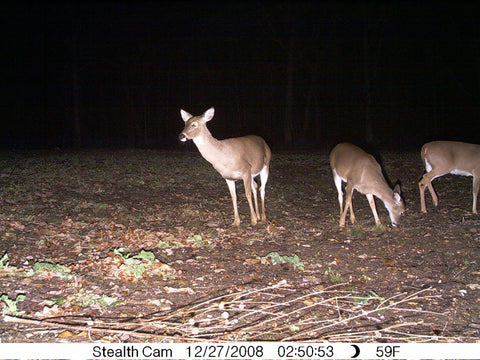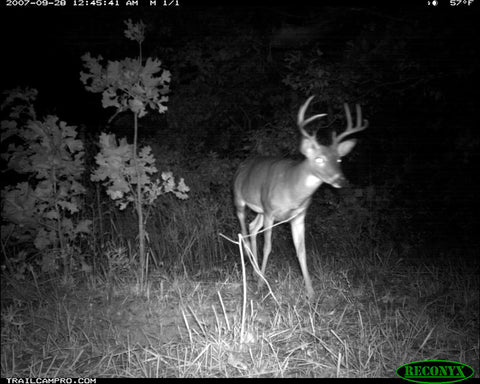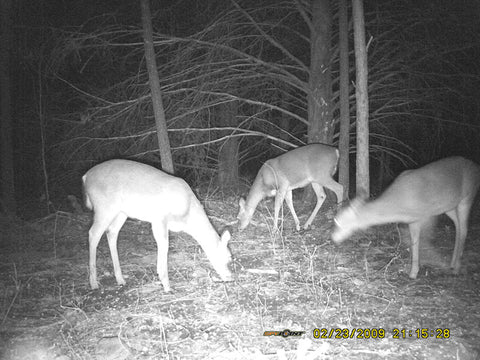Incandescent Vs. Infrared Game Cameras
Let's highlight some of the key points about each type of flash.
Incandescent Flash
- Captures full color images at night
- Resolution & quality are generally better
- Resolution & quality are generally better
- Uses more energy than infrared
-
Battery life is decreased compared to infrared
-
Trigger time is slower than infrared
- Spooks some game
-
Deters some animals from entering camera area
- Attracts attention of other humans to camera location


Infrared Flash
- Captures black and white images at night
- Daytime images can be either black & white or color
- Nighttime resolution and quality are generally less than incandescent
- Pictures are sometimes blurry
- Requires very little power and no surge
- Battery life is increased compared to incandescent
- Trigger time is faster than incandescent
- Infrared flash doesn't spook game
- Infrared flash doesn't deter animals from entering camera area
- Infrared flash will not draw the attention of other humans


Standard incandescent flashes spook deer
After testing dozens of different trail cameras in every setting imaginable there is no doubt standard incandescent flashes spook some animals. Having said this, I can also tell you some animals seem unaffected. In fact, we have seen sizeable bucks visit an incandescent camera site repeatedly and behave as if they were posing for the camera. However, the fact remains, Incandescent flashes spook animals. To confirm this I set up two feeders near the same area; one with a standard flash, the other with an infrared flash. Both feeding sites were identical in every aspect with the exception of the flashes. The infrared flash site drew roughly twice as many deer as the standard flash site. The occurrence of bucks at the infrared site was also significantly greater as well. Deer also stayed for longer periods of time at the infrared site. We all know big bucks are wary and frustratingly elusive. If your primary concern is tracking and bagging a trophy buck, I simply wouldn't risk scaring them with an incandescent flash.
Update 4/16/2007 -
It has been roughly 8 months since I set up my Incandescent vs Infrared feeding site tests. While I have changed out many different models of trail cameras, I have always kept each site strictly either an Infrared or Incandescent site. Initially the infrared site was drawing in roughly twice as much game as the incandescent site. However, it appears the infrared site has become increasingly more popular. I collected photos today and found 584 infrared pictures compared to only 111 pictures from the incandescent site over the same 10 day period. Clearly there are long term benefits to using an infrared hunting camera.
Spooking deer isn't the only thing to consider
Although not spooking game is important, infrared flashes also have many other advantages over incandescent flashes. Standard flashes require a tremendous amount of power when they are charging. As a result, they use considerably more battery capacity than an infrared flash. Most incandescent flashes draw in excess of 1 amp during use while most infrared units draw 25-50 milliamps. Also, the increased energy required by an incandescent flash slows trigger time. Trigger times on most infrared units are the same whether day or night. However, the nighttime trigger time of incandescent trail cameras is usually a full second slower than the daytime trigger speed.
Conclusion
If you're using trail cameras to scout and help you hunt, an infrared unit will take pictures quicker, last longer on a set of batteries and most importantly not scare deer from your hunting area. If a quality picture is what you're after pick an incandescent model.


































































